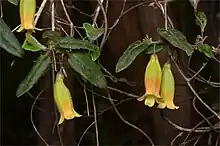| Orange bell-climber | |
|---|---|
 | |
| In the Grampians National Park | |
| Scientific classification | |
| Kingdom: | Plantae |
| Clade: | Tracheophytes |
| Clade: | Angiosperms |
| Clade: | Eudicots |
| Clade: | Asterids |
| Order: | Apiales |
| Family: | Pittosporaceae |
| Genus: | Marianthus |
| Species: | M. bignoniaceus |
| Binomial name | |
| Marianthus bignoniaceus | |
| Synonyms[1] | |
|
Billardiera bignoniacea (F.Muell.) E.M.Benn. | |
Marianthus bignoniaceus, commonly known as orange bell-creeper,[2] is a species of flowering plant in the family Pittosporaceae and is endemic to Victoria. It is a slender climber with egg-shaped or narrowly egg-shaped leaves and green and orange or salmon-pink flowers arranged singly or in pairs.
Description
Marianthus bignoniaceus is a slender twiner with reddish brown stems that are silky-hairy at first, but become glabrous as they age. Its adult leaves are egg-shaped or narrowly egg-shaped, 12–50 mm (0.47–1.97 in) long and 6–25 mm (0.24–0.98 in) wide on a short petiole. Both surfaces of the leaves have scattered, soft hairs. The flowers are borne singly or in pairs on a slender, pendent pedicel 3–7 mm (0.12–0.28 in) long, the sepals lance-shaped and joined at the base, 2–6 mm (0.079–0.236 in) long and covered with shaggy hairs. The five petals are 15–22 mm (0.59–0.87 in) long joined at the base to form a bell-shaped, green and orange or salmon-pink tube, the lobes 2–5 mm (0.079–0.197 in) long. Flowering mainly occurs from September to January, but flowers are often present all year.[2][3][4]
Taxonomy
Marianthus bignoniaceus was first formally described in 1854 by Ferdinand von Mueller in Transactions of the Philosophical Society of Victoria.[5][6] The specific epithet (bignoniaceus) means "two colours".[7]
Distribution and habitat
This climber grows in moist forest and dense scrubs near streams, sometimes between rocks in higher places and is found in the Grampians National Park and nearby Black Range in Victoria.[2][3]
References
- 1 2 "Marianthus bignoniaceus". Australian Plant Census. Retrieved 14 June 2023.
- 1 2 3 "Marianthus bignoniaceus". Australian Biological Resources Study, Department of Agriculture, Water and the Environment: Canberra. Retrieved 14 June 2023.
- 1 2 Walsh, Neville G.; Albrecht, David E.; Stajsic, Val. "Marianthus bignoniaceus". Royal Botanic Gardens Victoria. Retrieved 14 June 2023.
- ↑ "Billardiera bignoniacea". State Herbarium of South Australia. Retrieved 14 June 2023.
- ↑ "Marianthus bignoniaceus". APNI. Retrieved 14 June 2023.
- ↑ von Mueller, Ferdinand (1854). "Definitions of rare or hitherto undescribed Australian plants, chiefly collected within the boundaries of the colony of Victoria". Transactions of the Philosophical Society of Victoria. 1: 6–7. Retrieved 14 June 2023.
- ↑ Sharr, Francis Aubi; George, Alex (2019). Western Australian Plant Names and Their Meanings (3rd ed.). Kardinya, WA: Four Gables Press. p. 146. ISBN 9780958034180.